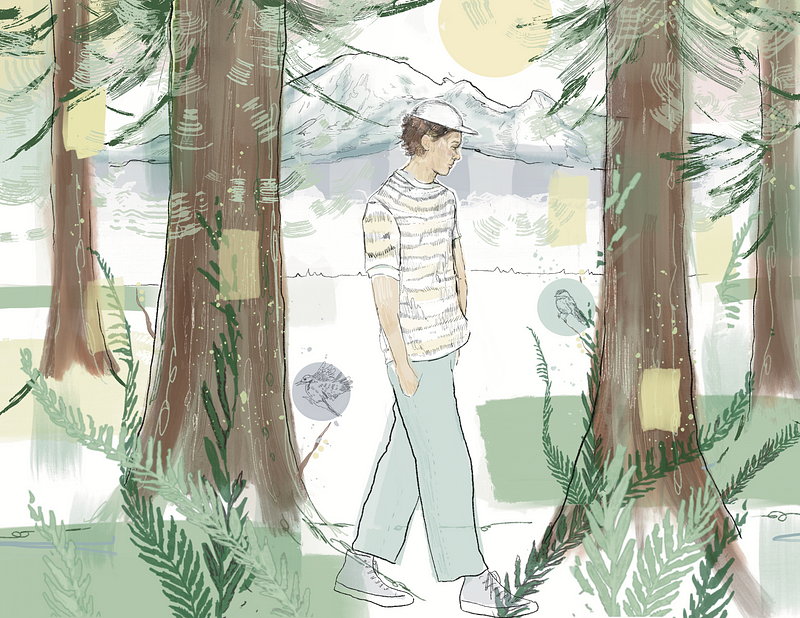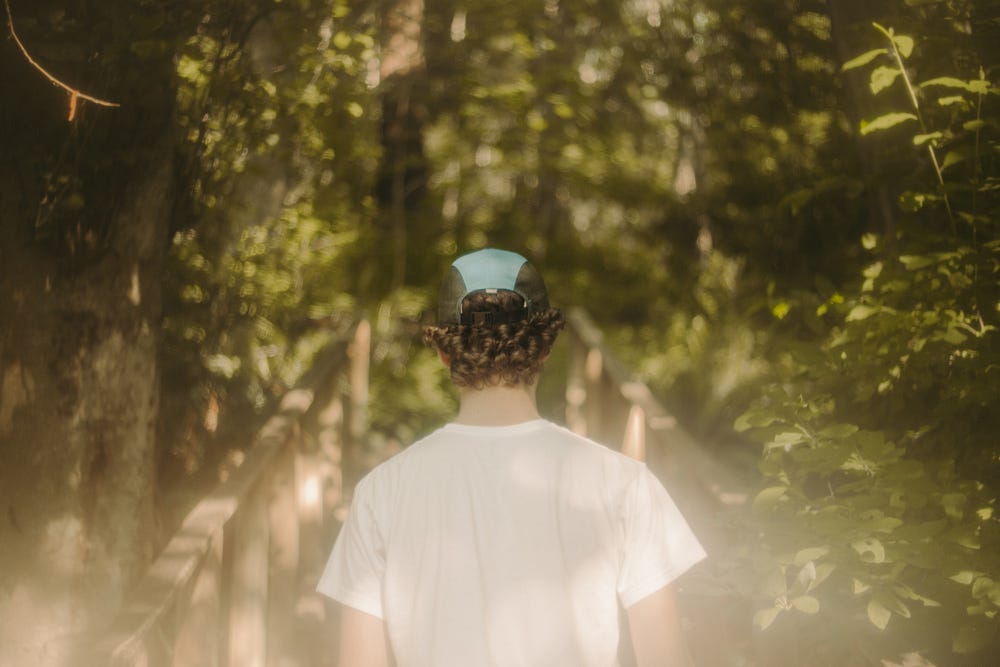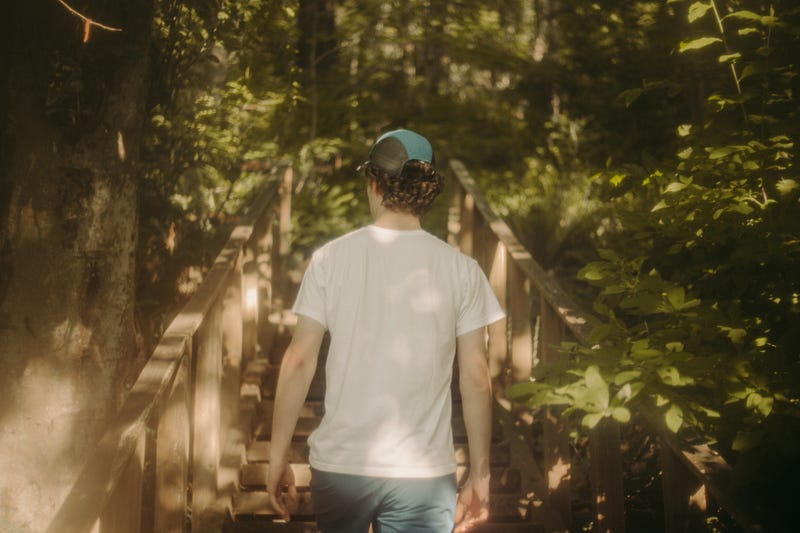The Speed of Slow

How putting one foot in front of the other opened endless possibilities.
Story by Nolan Baker | Content warning: anxiety, depression
The final climb of most of my walks around Bellingham, Washington end at the observation tower atop the Sehome Hill Arboretum. Looking west gives you a picturesque view of the city and stretches all the way to Victoria Island and beyond. To the east, you can just see the tip of Mount Baker, peeking out above the hills.
Early mornings in the first few months of the pandemic, I could walk through all of campus, up the observation tower and back home without seeing a single soul. Those moments of quiet stillness, gazing out onto the horizon without a thought going through my head, proved to be more valuable than I could ever imagine.


Nearly everyone has been stuck in their houses, apartments, garages and parents’ basements for the past year, and nearly everyone has had to find ways to cope with the emotions that naturally come with that sedentary lifestyle.
Boredom. Anxiety. Isolation. Loneliness.
The economic uncertainty, personal loss, fear and seclusion this pandemic has brought on the world can’t just be shrugged off. It seeps into your mind. It seeped into mine.
A host of studies suggest that the swirl of stressors surrounding the pandemic and the constant isolation demanded by it can lead to a rise in rates of anxiety and depression. A 2020 survey conducted by the Kaiser Family Foundation found that 53% of adult respondents felt that coronavirus-related worry or stress has negatively impacted their mental health, with younger adults reporting a higher rate than older adults.
The disappointment of knowing I’ll never again attend class on the campus I’m paying tens of thousands of dollars a year to attend. The resentment I harbor toward all things Zoom and online learning. The chilling loneliness of lockdown. The crushing boredom of the quarantine routine.
All these feelings I so easily carried. It took me a long time to realize what was going on, and an even longer time to figure out how to do something about it.
Months were passing by without my knowledge. Weeks would go by without leaving my house. Days slipped away without talking to anyone apart from my girlfriend and roommates.
It wasn’t until probably June 2020 — in a brief two-week window between spring and summer online classes — when I realized I hadn’t been outside for a reason not related to the garbage, the groceries, or my cat, for three weeks straight.
As a kid, I practically lived outside. I played sports year-round, camped with my friends in the summer and generally wanted to be out in the elements.
All my best, most vivid memories from my life were spent outdoors. Winning a city soccer championship on the team my dad coached, my cheap Walmart tent completely flooding on a camping trip with the Boys & Girls Club, saying “I love you” to my girlfriend for the first time on my front porch.
So when I eventually found my ass parked on my couch for the third hour of the third day of the third week of not going outside, I freaked out.
You know when you have a test or a huge project due, so you accomplish every chore you could possibly think of? That’s exactly what happened to me, but instead of studying for Introduction to Psychology, I knew I needed to get out of my house.
So I laced up my running shoes and bounded out the door.
[embed]https://uploads.knightlab.com/storymapjs/7e954a55f8d502f0c6b0d1804517b38b/the-speed-of-slow/index.html[/embed]
I don’t know why I instinctively started walking toward campus. I don’t know why I decided to stop playing video games and leave my quarantine cave.
What I did know was that it felt good to not roast my eyeballs on one of three screens. I hadn’t looked more than 15 feet in front of myself for what seemed like an eternity.
I assumed walking to campus was just my brain reverting to the “old world” of what my daily routine used to be. I was one of those kids who annoyingly wove my bike in between people on campus. My bike commute was one of the things I missed most about not having in-person classes.
As my body wandered around campus, so would my mind. Memories from “real life” school were triggered by every building, sidewalk and tree. It was easy to pretend I had some important class to get to or that I wasn’t the only person populating these once-bustling grounds.
By the time I stopped right before the entrance to the Arboretum, I began to realize how much I loved this: walking around, doing nothing, tuning into a podcast, listening to the birds chatter amongst themselves. It was exactly what my brain needed.

It turns out, human brains and bodies crave being outdoors.
A 2015 study from the Proceedings of the Natural Academy of Sciences found that exposure to nature can directly reduce the amount of “rumination,” or repetitive, negative self-thoughts and reduce the amount of neural activity in areas of the prefrontal cortex associated with risk for mental illness.
Another study by Northwestern University in 2019 found similar results. Their tests revealed that being outside and exercising in general has better mental and physical short-term outcomes than nothing. They also found that walking in a forested, natural environment has even greater outcomes than walking in an urban environment.
Living in Bellingham, I’m fortunate enough to be blocks away from a beautiful urban forest that is the Arboretum. Living in the Pacific Northwest, I’m even luckier to be miles away from countless trailheads, campsites and parks at my disposal.
It’s always astounded me how the call of a finch, the sight of a snow-capped mountain, or the smell of cedar can brighten up my mood. But what’s astounded me more is how easily I can forget those feelings and just stay inside.
After that first walk, I stayed cooped up in my house for a few more days. Again, I’m not exactly sure why.
But by the second or third walk, after I started switching up my routes and seeing new things, getting out of my house was no longer a problem.
Once those walks became weekly, and then near-daily occurrences, the rest of my stresses didn’t bother me as much as they used to.
I wish walking would make all my problems disappear. Unfortunately, I haven’t found a way for it to pay my rent. However, it does make my brain shut up for an hour or so, and that’s important too.
I never thought I’d be proud of myself for putting one foot in front of the other.
I never thought going outside and wandering around would be such a release.
I never thought my favorite hobby might just be walking through my neighborhood.